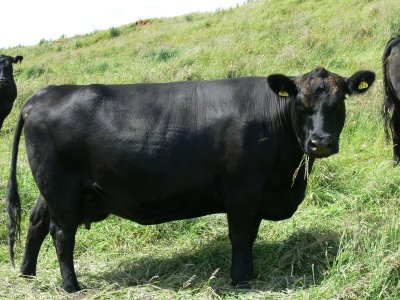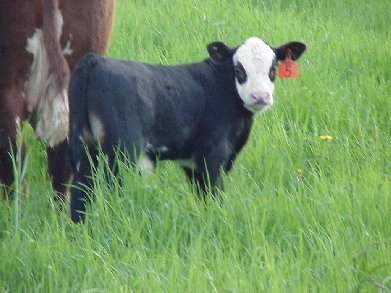
Managing animals with mob grazing
 Even though mob grazing's
primary focus is on the soil and plants, you don't want to ignore your
livestock. If you're building up poor soil, it won't be able to
support as many animals per acre, so pay attention to the oldest and
youngest animals to make sure they're healthy. Cattle shouldn't
have a dent on their left side --- that means they're not getting
enough to eat. Healthy cattle, on the other hand, will have a
shiny line down the neck that denotes good gland function (and keeps
flies away), and will lose their winter coats quickly. If your
cattle don't look healthy, give them more space (or feed them hay if
you must.)
Even though mob grazing's
primary focus is on the soil and plants, you don't want to ignore your
livestock. If you're building up poor soil, it won't be able to
support as many animals per acre, so pay attention to the oldest and
youngest animals to make sure they're healthy. Cattle shouldn't
have a dent on their left side --- that means they're not getting
enough to eat. Healthy cattle, on the other hand, will have a
shiny line down the neck that denotes good gland function (and keeps
flies away), and will lose their winter coats quickly. If your
cattle don't look healthy, give them more space (or feed them hay if
you must.)
Meanwhile, choose your
livestock wisely. Most modern cattle have been bred for size, but
you want to select for the ability to thrive on pasture 365 days a
year. Greg Judy had to go back to older varieties of cattle with
short legs, big bellies, and an oily streak down the back. His
full-grown bulls clock in at 1050 to 1100 pounds and his cows at 850 to
900 pounds, in contrast to some breeds that mature at 2000 to 2500
pounds. He culls relentlessly, removing cattle from his herd if
they're getting too thin, so his livestock become hardier every year.
 Greg also shifted management
patterns to make year-round grazing feasible. Rather than weaning
calves the way most cattle-farmers do, he selects for cows that are
smaller, then he gives them lots of forage so that the mothers are able
to stay healthy while raising their calves. He makes sure his
cows give birth around the first of April, when the pastures are just
starting to pick up speed, which means peak milk production arrives in
May when calves are big enough to handle it.
Greg also shifted management
patterns to make year-round grazing feasible. Rather than weaning
calves the way most cattle-farmers do, he selects for cows that are
smaller, then he gives them lots of forage so that the mothers are able
to stay healthy while raising their calves. He makes sure his
cows give birth around the first of April, when the pastures are just
starting to pick up speed, which means peak milk production arrives in
May when calves are big enough to handle it.
Finally, Greg doesn't
worry about parasites. One of the major benefits of rotational
grazing is that you move the animals quickly enough that cattle aren't
eating around their own feces, and by the time they come back through,
parasites have perished. That means Greg doesn't even give his
herd dewormer --- if the cows get sick, he figures they have bad genes
and he culls them.
 This post is part of our Mob Grazing lunchtime series.
Read all of the entries: This post is part of our Mob Grazing lunchtime series.
Read all of the entries:
|
Want more in-depth information? Browse through our books.
Or explore more posts by date or by subject.
About us: Anna Hess and Mark Hamilton spent over a decade living self-sufficiently in the mountains of Virginia before moving north to start over from scratch in the foothills of Ohio. They've experimented with permaculture, no-till gardening, trailersteading, home-based microbusinesses and much more, writing about their adventures in both blogs and books.
Want to be notified when new comments are posted on this page? Click on the RSS button after you add a comment to subscribe to the comment feed, or simply check the box beside "email replies to me" while writing your comment.
